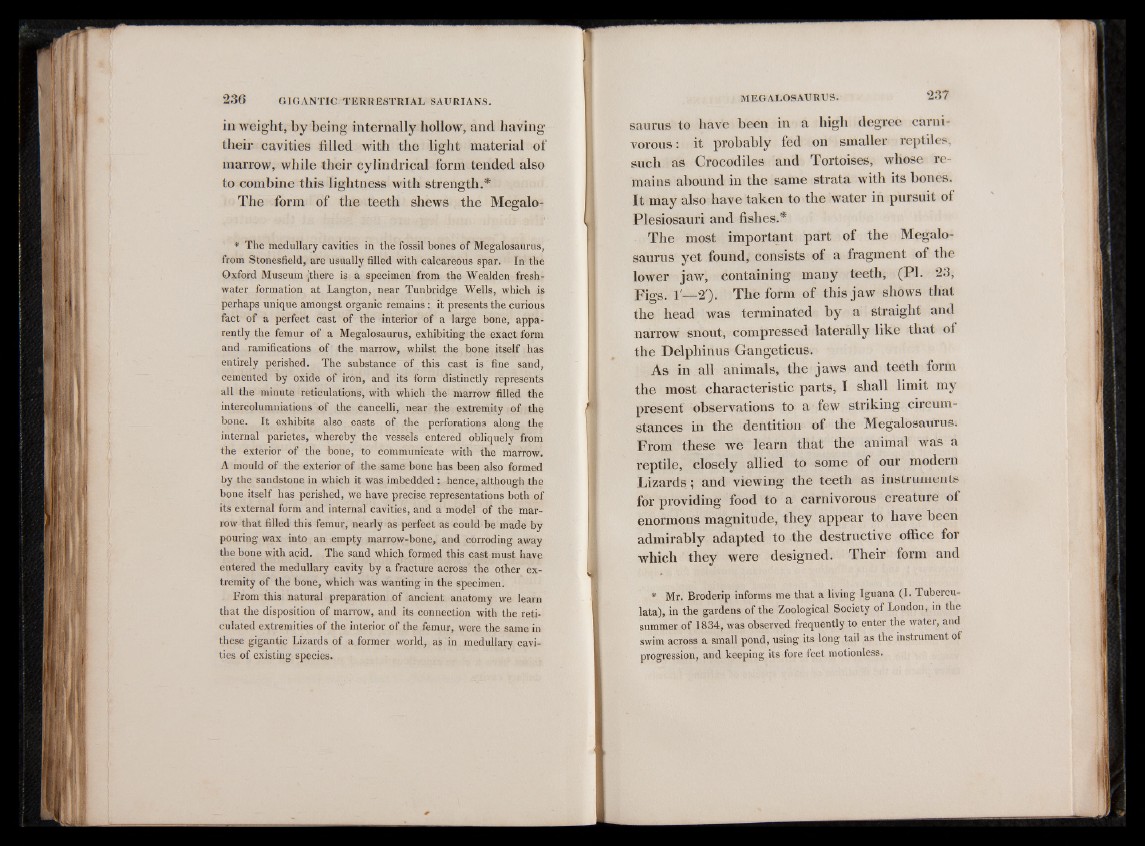
236
in weight, by being internally hollow, and having
their cavities filled with the light material of
marrow, while their cylindrical form tended also
to combine this lightness with strength.*
The form of the teeth shews the Megalo-
* The medullary cavities in the fossil bones of Megalosaurus,
from Stonesfield, are usually filled with calcareous spar. In the
Oxford Museum 'there is a specimen from the Wealden freshwater
formation at Langton, near Tunbridge Wells, which is
perhaps unique amongst organic remains: it presents the curious
fact of a perfect cast of the interior of a large bone, apparently
the femur of a Megalosaurus, exhibiting the exact form
and ramifications of the marrow, whilst the bone itself has
entirely perished. The substance of this cast is fine sand,
cemented by oxide of iron, and its form distinctly represents
all the minute reticulations, with which the marrow filled the
intercolumniations of the cancelli, near the extremity o f the
bone. It exhibits also casts of the perforations along the
internal parietes, whereby the vessels entered obliquely from
the exterior of the bone, to communicate with the marrow.
A mould of the exterior of the same bone has been also formed
by the sandstone in which it was imbedded : hence, although the
bone itself has perished, we have precise representations both of
its external form and internal cavities, and a model of the marrow
that filled this femur, nearly as perfect as could be made by
pouring wax into an empty marrow-bone, and corroding away
the bone with acid. The sand which formed this cast must have
entered the medullary cavity by a fracture across the other extremity
of the bone, which was wanting in the specimen.
From this natural preparation of ancient anatomy we learn
that the disposition of marrow, and its connection with the reticulated
extremities of the interior of the femur, were the same in
these gigantic Lizards of a former world, as in medullary cavities
of existing species.
saimis to have been in a high degree carnivorous:
it probably fed on smaller reptiles,
such as Crocodiles and Tortoises, whose remains
abound in the same strata with its bones.
It may also have taken to the water in pursuit of
Plesiosauri and fishes.*
The most important part of the Megalosaurus
yet found, consists of a fragment of the
lower jaw, containing many teeth, (PI. 23,
Figs. 1'— 2 ). The form of this jaw shows that
the head was terminated by a straight and
narrow snout, compressed laterally like that of
the Delphinus Gangeticus.
As in all animals, the jaws and teeth form
the most characteristic parts, I shall limit my
present observations to a few striking circumstances
in the dentition of the Megalosaurus.
From these we learn that the animal was a
reptile, closely allied to some of our modern
Lizards; and viewing the teeth as instruments
for providing food to a carnivorous creature of
enormous magnitude, they appear to have been
admirably adapted to the destructive office for
which they were designed. Their form and
* Mr. Broderip informs me that a living Iguana (I. Tubercu-
lata), in the gardens of the Zoological Society of London, in the
summer of 1834, was observed frequently to enter the water, and
swim across a small pond, using its long tail as the instrument of
progression, and keeping its fore feet motionless.